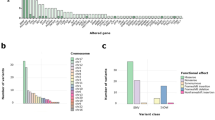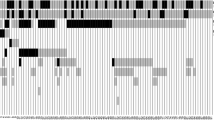Abstract
Introduction
Congenital glioblastomas (cGBMs) are uncommon tumors presenting in early infancy, variably defined as diagnosed at birth or at age less than 3 months by strict criteria, or more loosely, as occurring in very young children less than 12 months of age. Previous studies have shown that cGBMs are histologically indistinguishable from GBMs in older children or adults, but may have a more favorable clinical outcome, suggesting biological differences between congenital versus other GBMs. Due to the infrequency of cGBMs, especially when employing strict inclusion criteria, molecular features have not been sufficiently explored.
Methods
Archer FusionPlex Solid Tumor Kit, Archer VariantPlex Solid Tumor Kit, Illumina RNAseq were utilized to study cGBMs seen at our institution since 2002. A strict definition for cGBM was utilized, with only infants less than age 3 months at clinical presentation sought for this study.
Results
Of the 8 cGBM cases identified in our files, 7 had sufficient materials for molecular analyses, and 3 of 7 cases analyzed showed fusions of the ALK gene (involving MAP4, MZT2Bex2 and EML4 genes as fusion partners). One case showed ROS1 fusion. Somatic mutations in TSC22D1, BMG1 and DGCR6 were identified in 1 case. None of the cases showed alterations in IDH1/2, histone genes, or the TERT gene, alterations which can be associated with GBMs in older children or adults.
Conclusions
Our results show that cGBMs are genetically heterogeneous and biologically different from pediatric and adult GBMs. Identification of ALK and ROS1 raise the possibility of targeted therapy with FDA-approved targeted inhibitors.


Similar content being viewed by others
References
Solitare GB, Krigman MR (1964) Congenital intracranial neoplasm. A case report and review of the literature. J Neuropathol Exp Neurol 23:280–292
Anestis DM, Tsitsopoulos PP, Ble CA, Tsitouras V, Tsonidis CA (2017) Congenital glioblastoma multiforme: an unusual and challenging tumor. Neuropediatrics 48:403–412. https://doi.org/10.1055/s-0037-1601858
Cocce MC, Mardin BR, Bens S, Stutz AM, Lubieniecki F, Vater I, Korbel JO, Siebert R, Alonso CN, Gallego MS (2016) Identification of ZCCHC8 as fusion partner of ROS1 in a case of congenital glioblastoma multiforme with a t(6;12)(q21;q24.3). Genes Chromosom Cancer 55:677–687. https://doi.org/10.1002/gcc.22369
Isaacs H Jr (2016) Perinatal (fetal and neonatal) astrocytoma: a review. Childs Nerv Syst 32:2085–2096. https://doi.org/10.1007/s00381-016-3215-y
Kameda M, Otani Y, Ichikawa T, Shimada A, Ichimura K, Date I (2017) Congenital glioblastoma with distinct clinical and molecular characteristics: case reports and a literature review. World Neurosurg 101:817. https://doi.org/10.1016/j.wneu.2017.02.026
Lake JA, Donson AM, Prince E, Davies KD, Nellan A, Green AL, Mulcahy Levy J, Dorris K, Vibhakar R, Hankinson TC, Foreman NK, Ewalt MD, Kleinschmidt-DeMasters BK, Hoffman LM, Gilani A (2019) Targeted fusion analysis can aid in the classification and treatment of pediatric glioma, ependymoma, and glioneuronal tumors. Pediatr Blood Cancer. https://doi.org/10.1002/pbc.28028
Macy ME, Birks DK, Barton VN, Chan MH, Donson AM, Kleinschmidt-Demasters BK, Bemis LT, Handler MH, Foreman NK (2012) Clinical and molecular characteristics of congenital glioblastoma. Neuro Oncol 14:931–941. https://doi.org/10.1093/neuonc/nos125
Milano GM, Cerri C, Ferruzzi V, Capolsini I, Mastrodicasa E, Genitori L, Aversa F (2009) Congenital glioblastoma. Pediatr Blood Cancer 53:124–126. https://doi.org/10.1002/pbc.22008
Ng A, Levy ML, Malicki DM, Crawford JR (2019) Unusual high-grade and low-grade glioma in an infant with PPP1CB-ALK gene fusion. BMJ Case Rep. https://doi.org/10.1136/bcr-2018-228248
Nsir AB, Darmoul M, Hadhri R, Hattab N (2017) Congenital glioblastoma: lessons learned from a rare case with unusual presentation. Turk Neurosurg 27:464–467. https://doi.org/10.5137/1019-5149.JTN.13047-14.3
Olsen TK, Panagopoulos I, Meling TR, Micci F, Gorunova L, Thorsen J, Due-Tonnessen B, Scheie D, Lund-Iversen M, Krossnes B, Saxhaug C, Heim S, Brandal P (2015) Fusion genes with ALK as recurrent partner in ependymoma-like gliomas: a new brain tumor entity? Neuro Oncol 17:1365–1373. https://doi.org/10.1093/neuonc/nov039
Shimamura N, Asano K, Ogane K, Yagihashi A, Ohkuma H, Suzuki S (2003) A case of definitely congenital glioblastoma manifested by intratumoral hemorrhage. Childs Nerv Syst 19:778–781. https://doi.org/10.1007/s00381-003-0807-0
Thankamony A, Harlow FH, Ponnampalam J, Clarke P (2007) Congenital brain tumour mimicking fetal intracranial haemorrhage. J Obstet Gynaecol 27:314–317. https://doi.org/10.1080/01443610701241217
Yoshihara K, Wang Q, Torres-Garcia W, Zheng S, Vegesna R, Kim H, Verhaak RG (2015) The landscape and therapeutic relevance of cancer-associated transcript fusions. Oncogene 34:4845–4854. https://doi.org/10.1038/onc.2014.406
Guerreiro Stucklin AS, Ryall S, Fukuoka K, Zapotocky M, Lassaletta A, Li C, Bridge T, Kim B, Arnoldo A, Kowalski PE, Zhong Y, Johnson M, Li C, Ramani AK, Siddaway R, Nobre LF, de Antonellis P, Dunham C, Cheng S, Boue DR, Finlay JL, Coven SL, de Prada I, Perez-Somarriba M, Faria CC, Grotzer MA, Rushing E, Sumerauer D, Zamecnik J, Krskova L, Garcia Ariza M, Cruz O, Morales La Madrid A, Solano P, Terashima K, Nakano Y, Ichimura K, Nagane M, Sakamoto H, Gil-da-Costa MJ, Silva R, Johnston DL, Michaud J, Wilson B, van Landeghem FKH, Oviedo A, McNeely PD, Crooks B, Fried I, Zhukova N, Hansford JR, Nageswararao A, Garzia L, Shago M, Brudno M, Irwin MS, Bartels U, Ramaswamy V, Bouffet E, Taylor MD, Tabori U, Hawkins C (2019) Alterations in ALK/ROS1/NTRK/MET drive a group of infantile hemispheric gliomas. Nat Commun 10:4343. https://doi.org/10.1038/s41467-019-12187-5
Brat DJ, Shehata BM, Castellano-Sanchez AA, Hawkins C, Yost RB, Greco C, Mazewski C, Janss A, Ohgaki H, Perry A (2007) Congenital glioblastoma: a clinicopathologic and genetic analysis. Brain Pathol 17:276–281. https://doi.org/10.1111/j.1750-3639.2007.00071.x
Benelli M, Pescucci C, Marseglia G, Severgnini M, Torricelli F, Magi A (2012) Discovering chimeric transcripts in paired-end RNA-seq data by using EricScript. Bioinformatics 28:3232–3239. https://doi.org/10.1093/bioinformatics/bts617
Whiteway SL, Betts AM, O’Neil ER, Green AL, Gilani A, Orr BA, Mathis DA (2020) Oncogenic GOPC-ROS1 fusion identified in a congenital glioblastoma case. J Pediatr Hematol Oncol (accepted for publication)
Nakashiro K, Kawamata H, Hino S, Uchida D, Miwa Y, Hamano H, Omotehara F, Yoshida H, Sato M (1998) Down-regulation of TSC-22 (transforming growth factor beta-stimulated clone 22) markedly enhances the growth of a human salivary gland cancer cell line in vitro and in vivo. Cancer Res 58:549–555
El-Ayadi M, Ansari M, Sturm D, Gielen GH, Warmuth-Metz M, Kramm CM, von Bueren AO (2017) High-grade glioma in very young children: a rare and particular patient population. Oncotarget 8:64564–64578. https://doi.org/10.18632/oncotarget.18478
Brat DJ, Aldape K, Colman H, Holland EC, Louis DN, Jenkins RB, Kleinschmidt-DeMasters BK, Perry A, Reifenberger G, Stupp R, von Deimling A, Weller M (2018) cIMPACT-NOW update 3: recommended diagnostic criteria for “Diffuse astrocytic glioma, IDH-wildtype, with molecular features of glioblastoma, WHO grade IV”. Acta Neuropathol 136:805–810. https://doi.org/10.1007/s00401-018-1913-0
Dolecek TA, Propp JM, Stroup NE, Kruchko C (2012) CBTRUS statistical report: primary brain and central nervous system tumors diagnosed in the United States in 2005–2009. Neuro Oncol 14(Suppl 5):v1–49. https://doi.org/10.1093/neuonc/nos218
Korshunov A, Ryzhova M, Hovestadt V, Bender S, Sturm D, Capper D, Meyer J, Schrimpf D, Kool M, Northcott PA, Zheludkova O, Milde T, Witt O, Kulozik AE, Reifenberger G, Jabado N, Perry A, Lichter P, von Deimling A, Pfister SM, Jones DT (2015) Integrated analysis of pediatric glioblastoma reveals a subset of biologically favorable tumors with associated molecular prognostic markers. Acta Neuropathol 129:669–678. https://doi.org/10.1007/s00401-015-1405-4
Davis T, Doyle H, Tobias V, Ellison DW, Ziegler DS (2016) Case report of spontaneous resolution of a congenital glioblastoma. Pediatrics. https://doi.org/10.1542/peds.2015-1241
Scheuermann A, Belongia M, Lawlor MW, Suchi M, Kaufman B, Vasudevaraja V, Serrano J, Snuderl M, Knipstein J (2019) Ganglioglioma in a survivor of infantile glioblastoma. J Pediatr Hematol Oncol. https://doi.org/10.1097/MPH.0000000000001417
Johnson A, Severson E, Gay L, Vergilio JA, Elvin J, Suh J, Daniel S, Covert M, Frampton GM, Hsu S, Lesser GJ, Stogner-Underwood K, Mott RT, Rush SZ, Stanke JJ, Dahiya S, Sun J, Reddy P, Chalmers ZR, Erlich R, Chudnovsky Y, Fabrizio D, Schrock AB, Ali S, Miller V, Stephens PJ, Ross J, Crawford JR, Ramkissoon SH (2017) Comprehensive genomic profiling of 282 pediatric low- and high-grade gliomas reveals genomic drivers, tumor mutational burden, and hypermutation signatures. Oncologist 22:1478–1490. https://doi.org/10.1634/theoncologist.2017-0242
Davies KD, Doebele RC (2013) Molecular pathways: ROS1 fusion proteins in cancer. Clin Cancer Res 19:4040–4045. https://doi.org/10.1158/1078-0432.CCR-12-2851
Shaw AT, Engelman JA (2013) ALK in lung cancer: past, present, and future. J Clin Oncol 31:1105–1111. https://doi.org/10.1200/JCO.2012.44.5353
Camidge DR, Doebele RC (2012) Treating ALK-positive lung cancer–early successes and future challenges. Nat Rev Clin Oncol 9:268–277. https://doi.org/10.1038/nrclinonc.2012.43
Drilon A, Siena S, Ou SI, Patel M, Ahn MJ, Lee J, Bauer TM, Farago AF, Wheler JJ, Liu SV, Doebele R, Giannetta L, Cerea G, Marrapese G, Schirru M, Amatu A, Bencardino K, Palmeri L, Sartore-Bianchi A, Vanzulli A, Cresta S, Damian S, Duca M, Ardini E, Li G, Christiansen J, Kowalski K, Johnson AD, Patel R, Luo D, Chow-Maneval E, Hornby Z, Multani PS, Shaw AT, De Braud FG (2017) Safety and antitumor activity of the multitargeted pan-TRK, ROS1, and ALK inhibitor entrectinib: combined results from two phase I trials (ALKA-372-001 and STARTRK-1). Cancer Discov 7:400–409. https://doi.org/10.1158/2159-8290.CD-16-1237
Laetsch TW, DuBois SG, Mascarenhas L, Turpin B, Federman N, Albert CM, Nagasubramanian R, Davis JL, Rudzinski E, Feraco AM, Tuch BB, Ebata KT, Reynolds M, Smith S, Cruickshank S, Cox MC, Pappo AS, Hawkins DS (2018) Larotrectinib for paediatric solid tumours harbouring NTRK gene fusions: phase 1 results from a multicentre, open-label, phase 1/2 study. Lancet Oncol 19:705–714. https://doi.org/10.1016/S1470-2045(18)30119-0
Acknowledgements
This work was supported, in part, by the UCD Molecular Pathology Shared Resource (MPSR) and the UCD Genomics and Microarray Core (National Cancer Institute Cancer Center Support Grant No. P30-CA046934). Additional financial assistance was received from the Morgan Adams Foundation, and the Olivia Caldwell Foundation.
Author information
Authors and Affiliations
Contributions
AD, KDD, SLW, JL, JDS, LH, NKF, BKKDM, ALG, and AG: Substantial contributions to the conception and design of the study; acquisition, analysis, and interpretation of data; AD, KDD, BKKDM and AG provided images for figures. AD, NKF and AG prepared the manuscript. AG, AD, NKF, BKKDM and ALG: critical manuscript review and revisions. AG: Contribution as per journal requirements; KDD: Supervised molecular testing, provided images of fusion breakpoints for figure.
Corresponding author
Ethics declarations
Conflict of interest
Kurt D. Davis has received sponsored travel from ArcherDx. Other authors report no conflicts of interest related to this study.
Ethical approval
All procedures performed in studies involving human participants were in accordance with the ethical standards of the institutional and/or national research committee and with the 1964 Helsinki declaration and its later amendments or comparable ethical standards.
Human and animal rights statement
This article does not contain any studies with animals performed by any of the authors.
Informed consent
Informed consent was obtained from all individual participants included in the study.
Additional information
Publisher's Note
Springer Nature remains neutral with regard to jurisdictional claims in published maps and institutional affiliations.
Rights and permissions
About this article
Cite this article
Gilani, A., Donson, A., Davies, K.D. et al. Targetable molecular alterations in congenital glioblastoma. J Neurooncol 146, 247–252 (2020). https://doi.org/10.1007/s11060-019-03377-8
Received:
Accepted:
Published:
Issue Date:
DOI: https://doi.org/10.1007/s11060-019-03377-8




